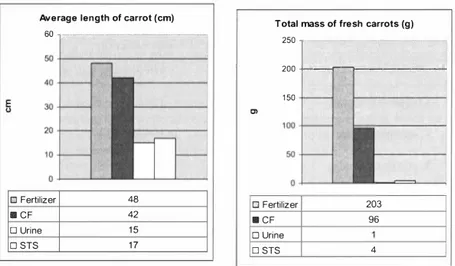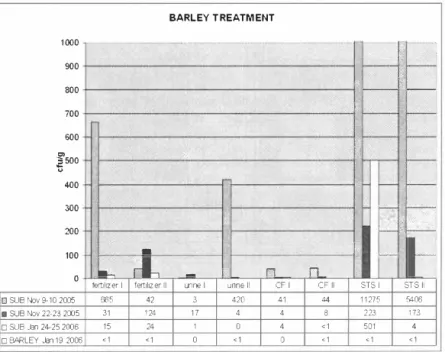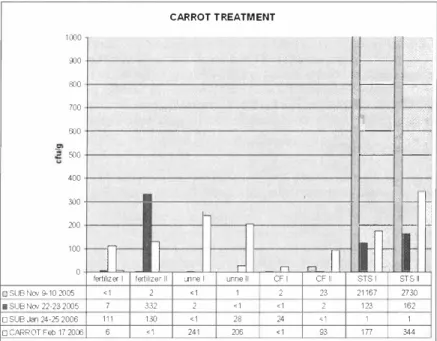BIOLOGICAL CONTAMINATION OF BARLEY
AND CARROTS BY PATHOGENS IN SOIL
FERTILISED WITH ANTHROPOGENIC
NUTRIENTS
Hanna Launokorpi
Marjukka Dyer
Eeva-Liisa Viskari
TAMK University of Applied Sciences, Tampere, Finland
ABSTRACTThe aim of this study was to find out if the use of septic tank sludge, urine and composted faeces as fertilizer for barley and carrot crops would pose a health risk due to pathogen transfer,
This study was accomplished as a greenhouse experiment in the premises of the TAM K University of Applied Sciences, Tampere. The study concentrated on the qualitative detection of Salmonella and a quantitative detection of coliform bacteria in the growing medium - and more importantly, in the plant products. Methods used were based on instructions given on the compact salmonella (SL) detection plates and the Compact coliform (CF) detection plates with a modified method of standards SFS 3950 and SFS 4447. The results were compared among others to the European Commission regulation 2073/2005 on microbiological criteria for foodstuff
Salmonella was absent in the fertilizers, and thus its presence would be impossible in the plant products. Coliform bacteria were initially detected in the growing medium, but generally the amount decreased significantly within time. At the end of the experiment barley grains from the first urine duplicate and first composted faeces duplicate were totally free of coliform bacteria. Also, the amount of coliform bacteria in barley grains of other treatments was acceptable in hygienic terms, being less than I cfu/g. The amount of coliform bacteria in carrots grown in commercial fertilizer and composted faeces treatments were within the satisfactory limits. The small size of carrots from urine and septic tank sludge treatments did not allow complete handling, nevertheless, the amount of colony forming units was considered to be within the acceptable limit of 100-IO00 cfu/g. Results from this study indicate that the use of composted excreta and source separated human urine as fertilizer is not posing a health risk in terms of coliform bacteria. More thorough research, however, is needed in order to define the risk of other disease causing microbes, like enterococci and viruses.
KEYWORDS
Salmonella; Coliform bacteria; Barley; Carrot; Septic tank sludge; STS; Urine; Composted faeces.
I INTRODUCTION
On average, an adult person annually produces approximately 500 kg of urine and 50 kg of faeces. Of that, 5.7 kg is nitrogen, 0.6 kg is phosphorus and 1.2 kg is potassium. There is a considerable difference between both the nutrient and pathogen content of different excreta. Urine contains approximately 90% of N, 50-65% of P and 50-8 0% of K that is excreted by humans. [I] In addition, urine contains very little heavy metals and it is considered almost pathogen free, while faeces contain several pathogens. [2] In the past, human excreta was widely used as a fertilizer in fields due to its nutrient-rich content. Today, its usage, apart from countries for instance in East Asia, is more uncommon. [3]
The main reason for excreta use decline is the health risk it can pose to the environment, especially to the people working in the fields and those consuming the food products. [4] In most cases, however, the most significant health risks are a result of improper handling during the different phases - the excreta used is untreated, the crops are eaten raw and unwashed, and the levels of personal hygiene are low.
Several studies already support the idea of recycling more thoroughly the nutrients in excreta. For instance, the Ministry of Agriculture and Forestry in Finland studied the hygienic quality of sludge from different treatment plants in 2002 in a research project called Sewage Sludge and Sludge Products for Agricultural Use - a Study on Hygienic Quality. [5] They used several indicator bacteria, among others Salmonella and Escherichia coli. Both types of pathogens were found in all the raw sludge samples taken from 22 different treatment plants. However, after certain treatment, for instance in-vessel composting, salmonella was not found. [5] In addition, Heinonen-Tanski et al studied the outdoor cucumber cultivation fertilized with separated urine. Commercial fertilizers were used as a control and the results showed that there were no coliforms present in the cucumbers, though the urine used had not been preserved before utilization. [6]
By using excreta, the need of artificial fertilizers is lower and negative impacts on soil, air and water is reduced. Environmental impacts created by agriculture and its side products are not only a problem of third world countries, but also of the developed nations. For instance, the Baltic Sea suffers significantly from eutrophication due to an exceedingly great nutrient load from agriculture and industry. [7]
This study concentrates on investigating the health risks originating from pathogens, by using coliform bacteria and Salmonella as indicators of the hygienic level of the fertilizer, soil, and most importantly, the food product. The comparison was to be made with the EC regulation 2073/2005 of microbiological criteria for foodstuff [8 ]
2 METHODS
2.1 The greenhouse experiment
The experiment was to simulate as closely as possible the field conditions of the month of June in Finland. Daylight and temperature maximums were set to match these requirements. Barley (Hordeum vulgare var. Searle/I) and fungicide treated carrot seeds (Daucus carota var. Napoli Fl) were used as model plants in the experiment, which commenced in November 2005 and ended in February 2006.
The substrate was a mixture of unfertilised horticultural peat (Biolan), lime and sand, Two parallel treatments of both barley and carrot were used: commercial Keviitviljan Y3 -fertilizer for barley and Puutarhan keviit -fertilizer for carrot; 2 treatments for separated urine; 2 for composted human faeces, collected from private households and 2 for STS, collected from private households in municipality of Kangasala,
The amounts of fertilizers were determined based on the recommendations of the manufacturers of commercial fertilizers, The recommendation for Keviitviljan Y3 fertilizer was 50 kg/ha and for Puutarhan keviit -fertilizer 800 kg/ha. The nitrogen content was used as a determining factor in calculations for other fertilizers. The amounts of fertilizers and water added based on per hectare calculations are shown in Tables 1 and 2, The actual growth rates were of sizes (W*L *H) 0.26*0, 76*0.25 m,
Table I. Fertilizer type and amount and water added to barley,
BARLEY Hordeum VU/f!are var.
s
car et/Fertilizer Amount/ha Water Added/ha
Keviitviljan Y3 250 kg 1 14 583 I
Composted Faeces 877 1 kg 1 14 583 I
Separated Urine 4875 kg up tol l4 5831
Septic Tank Sludge 1 14 583 I None
Table 2. Fertilizer type and amount and water added to carrots.
CARROT Daucus carota var. NapoI Fl 1 Fertilizer Amount/ha Water Added/ha
Puutarhan keviit 400 kg 1 14 583 I
Composted Faeces 56 15 kg 1 14 583 I Separated Urine 3 125 kg up toll4 5831
2.2 Coliform detection
Colifonns were analysed by a modified method of standard SFS 3950 and SFS 4447, according to instructions given by the chromogenic Compact Dry CF plates (manufacturer HyServe/Gennany; supplier VWR Finland), which were used for the quantitative detection of colifonn bacteria, The plates were chosen due to their simplicity and rapid results. The standard SFS 4447 is used in water sampling, but is also recommended for use in sludge sampling and in cases where samples contain a great deal of sediment. The dilutions were made based on the SFS 4447 according to the dilution water of SFS 3950. [9] The samples were taken three times from the soil and at the experiment's end, once from foodstuff, i.e. carrots and barley grains.
2.3 Salmonella detection
Salmonella was detected according to instructions provided for the Compact SL plates (HyServe/Gennany), which were used for the qualitative detection of salmonella. The plates were chosen because of their simplicity and rapidity. Salmonella was first analysed from the various fertilizers, i.e. urine, STS, composted faeces, and a blank substrate, which was a mixture of peat, sand and lime, Later, samples from the soil mixture ingredients (i.e. peat and sand) and the seeds of barley and carrots were examined.
3 RES UL TS AND DISCUSSION 3.1 The crop yield
The crop yield of carrots was best in substrate fertilized with the commercial fertilizer as can be seen from Figure I.
Average length of carrot (cm) Total mass of fresh carrots (g) 60 TC"'"''""C""'-·---·---• 250 200 .J..----r--.---1 150 C) □ Fertilizer 48 ■ CF 42 □ Urine 15 DSTS 17 □ Fertilizer 203 ■CF 96 □ Urine DSTS 4
32+----400 30 +----,---, 34 75 53
The second best yield was from the use of composted faeces, with urine and STS fertilized substrates yielding the smallest crops. The best barley crop yield was also grown in the substrate of commercial fertilizer as indicated in Figure 2.
Number of barley grains Mass of 1000 barley grains (g)
500 �---� C) 28 26+---'-� D Fertilizer 30 ■ CF o Urine DSTS 33 35 □ Fertilizer 467
■
CF 201 D Urine 310 DSTS 243Mass of barley grains (g) Average length of straw (mm)
16 �--- 80 14
+-�-�---'
70 12 60 10 50 E C) 8 E 40 6 30 4 20�-�-2 10 0+--�-0 -'--�--D Fertilizer 14■
CF 7 o Urine 11 OSTS 8 D Fertilizer■
CF D Urine 59 DSTS 57 Figure 8. Physical.features of barley,3.2 Occurrence of Salmonella and coliform bacteria
There was no Salmonella spp. present in any of the samples analysed.
The results from the coliform bacteria detection are presented in Figures 3 and 4 as colony forming units (cfu) per I gram for each crate in order to compare the results with the EC regulation of microbiological criteria for foodstuff.
The control substrates were those treated with commercial fertilizers. With both barley and carrot, commercial fertilizers' showed the second greatest amounts of coliform bacteria
contain a small amount of coliform bacteria, which originate for instance from birds and warm-blooded animals ..
Some divergence between results was noted, however, the reasons for this can be rather easily explained. The amount of coliform bacteria at the start of the study was clearly highest in substrates fertilized with septic tank sludge, which was anticipated. The urine substrates were the cleanest in terms of coliform bacteria. In the substrate of barley, using urine II, contamination most likely took place, since the level of bacteria was already high compared to the duplicate and the carrot crates fertilized with urine. In addition to contamination, another reason for differences can be due to deficient homogenisation of the sample, resulting in varying amounts of bacteria in the different duplicates. In general, incomplete mixing of excreta in the substrate causes differences in the amount of bacteria in the same sample. The most important goal of this study was to determine whether or not pathogens transfer from fertilizer to the end product, in this case, carrots and barley grains. Barley grains from substrates' urine I and composted faeces I were completely free of colifonn bacteria, and all the other barley substrates were almost completely free.
BARLEY TREATMENT 1000 r, l
Ii
900 rn 800 if _11' -• M 700 600w
% It 'j fsoo 400jf
300J:c·
200 100--r-1-a
-
-
Pi'! fl>
ll
-
H
N! 0ferbhzer I fertilizer II t.r1ne I urine II CF I CF II STSI STSII
D SUB Nov 9-10 2005 665 42 3 420 41 44 11275 5400
■ SUB Nov 22-23 2005 31 124 17 4 4 8 223 173
D SUB J3rl 24-25 2006 15 24 1 0 4 <1 501 4
D BARLEY Jan 19 2000 <1 <1 0 <1 0 < 1 <1 <1
Figure 9. Coliform bacteria in the barley substrates and barley grains.
STS treated carrot samples contained high amounts of colifonn bacteria. The amount of coliforms urine treatments was also over 200 cfu/g. This can be explained by the pre treatment of carrot samples before analysis. It was necessary to peel the carrots in order to find out whether or not the coliform bacteria had survived. Due to the small size of urine and STS treated carrots, however, it was impossible to peel them properly.
<1 CARROT TREATMENT 1000 ,. 000
'
�
�
H
000�
1/ 700 000;�
-
t
F
--;
:IJO-
-400 300
ti_
-
-
]
200 10011
-
I
'
rt ..-,11
tf}-
t
0fert1hzer I fert1l1zer II umel unne II CFI CF II STSI STSII 21167 2730 2 <1 1 2 23 □ SUB No, S-10 2005 <1 ■ SUB No, 22-23 2005 7 332 2 ,1 2 123 162 1 1 130 ,1 28 24 <1 o SUB Jan 24-25 2006 111 <1 2 41 206 ,1 93 1TT 344 □ CAAROT Feb 17 2000 6
Figure IO. Coliform bacteria in the carrot substrates and carrots. 4 CONCLUSIONS
The results of this study indicate that human excreta compost could be used as fertilizer without it posing a significant pathogen risk for the users or consumers of the foodstuffs produced. Preliminary results from our recent studies support this finding and show that also urine is a safe fertilizer for many crops (Viskari et al. unpublished data). Urine has to be added, however, in three-four consecutive times during the initial phase of cultivation in order to achieve the best yield.
No Salmonella was found from the fertilizer products. Coliform bacteria were found in all fertilizers and the amount was highest in STS, which was expected. The decrease in coliform bacteria amounts in growth substrate during the first two weeks of the experiment was remarkable indicating a clear decrease in the pathogen risk. After two weeks the amounts in growth substrate were also in all treatments significantly lower than is allowed for fertilizer products in Finland [ I OJ.
The study for barley grains indicated that the amount of coliform bacteria was well under the satisfactory limit of I 00 cfu/g, with all grains resulting in less than I cfu/g. Similarly, the barley crop yield did not greatly vary depending upon the type of fertilizer. The conclusion of this study then, is that composted human excreta used as a barley fertilizer does not pose any significant risks to human health.
sludge treated substrates, the amounts exceeded a satisfactory limit, but were nevertheless still within in the acceptable limit. This latter result however, is due to the small size of the carrots, which inhibited proper peeling and thus were exposed to soil contamination. This study therefore indicates that the use of composted faeces and urine as a fertilizer for carrots does not pose any significant risk to human health according to the studied indicators. The study leaves, however, some open questions, like the possible risk of other pathogens: enterococci, clostridia and viruses. These in fact have been studied in more detail and preliminary results indicate that the health risk is almost nonexistent with urine and composted faeces,
ACKNOWLEDGEMENTS
This project was done for T AMK University of Applied Sciences. The authors would like to thank all the people working within this study. Special thanks for Sisli Piisila and Ari Laukkanen for their work.
REFERENCES
[I) HEINONEN-TANSKI H., VAN WIJK-SIJBESMA C. Human excreta for plant production [online]. Bioresource Technology 96 (2005) 403-41 I [cited 3.5.2006). Available from World Wide Web: http://www.sciencedirect.com
(2) WECKMAN, ANJA, Ravinleel kiiymiiliislii pelroon [online). Luopioinen: 16.7.2005
(cited 10.2.2007). Available from World Wide Web:
http://www.huussi.net/tietoa/pdf/ Anja_ Weckman. pdf
(3) WECKMAN, ANJA, Ihmisen ulosteet lannoitteina. Tyotehoseuran monisteita 1/2000.
Helsinki: Tyotehoseura, 2000. ISBN 951-788-300-5,
(4) WORLD HEALTH ORGANIZATION. Guidelines for the safe use of wastewater, excreta and greywaler, Volume 4: Excreta and greywater use in agriculrure. World Health Organization, 2006. ISBN 92-4-154685-9.
(5) VUORINEN ARJA (ed.) et al. Sewage sludge and sludge products for agricultural use - a study on hygienic quality, Maa- ja metsatalousministerio, LIV AKE-2001-2002. Helsinki: 2003. ISBN 952-453- 1 I 3-5,
(6) HEINONEN-TANSKI, HELVI et al. Pure human urine is a good fertiliser for cucumbers [online]. Bioresource Technology 98 (2006) 2 14-2 17 [cited 15.2.2007). Available from World Wide Web: http://www.sciencedirect.com
(7) BALTIC SEA PORTAL Eutrophication of the Balric Sea [online]. Finnish Marine
Research Institute, 3.4.2007 [cited 12.2.2007), Available from World Wide Web: http://www.itameriportaali.fi/en/tietoa/artikkelit/ihminen/en_GB/rehevoityminen_itame ri/
(8 ) COMMISSION REGULATION 2073/2005. Microbiological criteria of foodstuff
[online]. Brussels: European Commission, I 5. I I,2005 [cited I 1.2.2007]. Available from
World Wide Web: http://eur
Iex.europa.eu/Lex UriServ/site/en/oj/2005/1_338/1_3382005 I 222en000 I 0026.pdf [9] SUOMEN STANDARDISOIMISLIITTO. Mikrobiologiset vesitutkimusmenetelmiit
2003. SFS-kasikirja 94. 3. ed. Helsinki: Kyriiri Oy, 2003. ISBN 952-5420- 15-9,
[IO] MINISTRY OF AGRICULTURE AND FORESTRY . 2007.Ministry of Agriculture and Forestry decree on fertilizer products. 12/07. [cited 30.9.2007]. Available from World Wide Web: www.finlex.fi (In Finnish)




